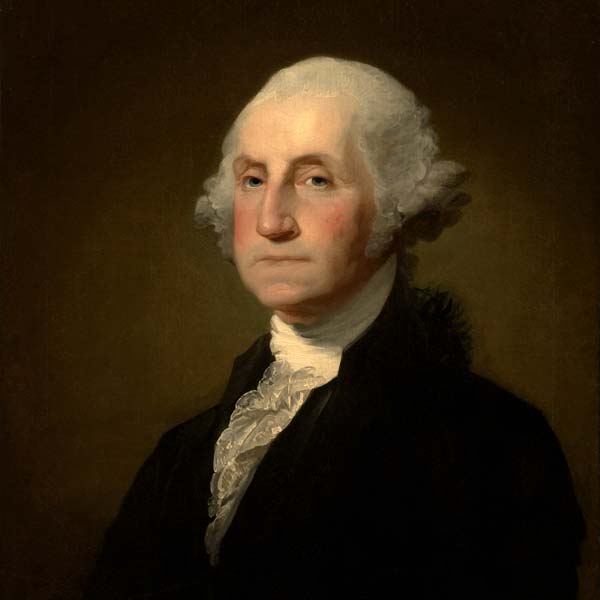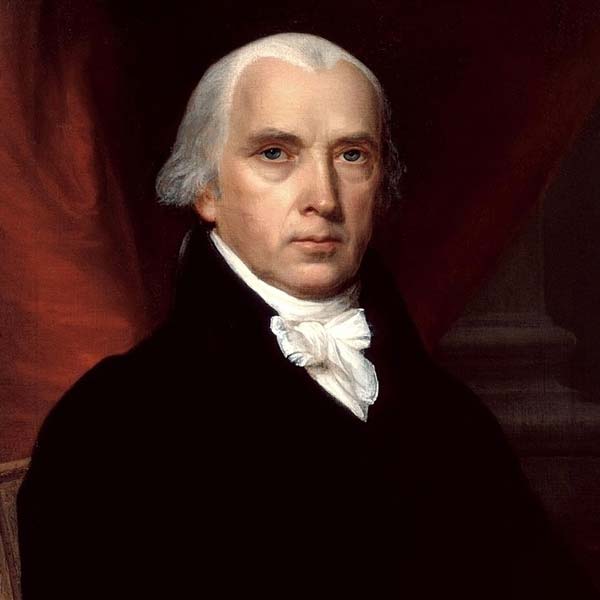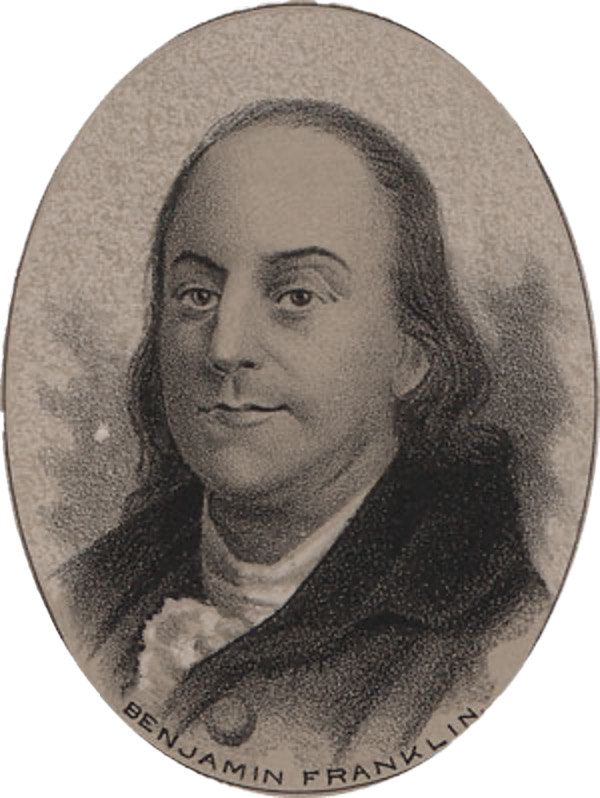
State: Virginia
Age at Convention: 55
Date of Birth: February 22, 1732
Date of Death: December 14, 1799
Schooling: Private Tutors, Honorary L.L.D. from Harvard 1776
Occupation: Planter and Slave Holder, General of the Continental Army, Lending and Investments, Real Estate Land Speculations, Public Security Interests
Prior Political Experience: Virginia House of Burgesses 1759-1774, Continental Congress 1774-1775, Commander in Chief of Continental Army 1775-1783
Committee Assignments: President of the Convention
Convention Contributions: Arrived May 25 and was present through the signing of the Constitution. He spoke only once near the end of the deliberations, but the record suggests that he had a profound influence on the scope and direction of the discussions. William Pierce stated that “having conducted these States to independence and peace, he now appears to assist in framing a Government to make the People happy. Like Gustavus Vasa, he made be said to be the deliverer of his Country.”
New Government Participation: He supported ratification of the Constitution by the State of Virginia. He was unanimously elected by the Electoral College as President of the United States (1788 – 1796). He used his Presidential powers to put down the Whisky Rebellion (1794).
Biography from the National Archives: The eldest of six children from his father’s second marriage, George Washington was born into the landed gentry in 1732 at Wakefield Plantation, VA. Until reaching 16 years of age, he lived there and at other plantations along the Potomac and Rappahannock Rivers, including the one that later became known as Mount Vernon. His education was rudimentary, probably being obtained from tutors but possibly also from private schools, and he learned surveying. After he lost his father when he was 11 years old, his half-brother Lawrence, who had served in the Royal Navy, acted as his mentor. As a result, the youth acquired an interest in pursuing a naval career, but his mother discouraged him from doing so.
At the age of 16, in 1748, Washington joined a surveying party sent out to the Shenandoah Valley by Lord Fairfax, a land baron. For the next few years, Washington conducted surveys in Virginia and present West Virginia and gained a lifetime interest in the West. In 1751-52 he also accompanied Lawrence on a visit he made to Barbados, West Indies, for health reasons just before his death.
The next year, Washington began his military career when the royal governor appointed him to an adjutantship in the militia, as a major. That same year, as a gubernatorial emissary, accompanied by a guide, he traveled to Fort Le Boeuf, Pennsylvania, in the Ohio River Valley, and delivered to French authorities an ultimatum to cease fortification and settlement in English territory. During the trip, he tried to better British relations with various Indian tribes.
In 1754, winning the rank of lieutenant colonel and then colonel in the militia, Washington led a force that sought to challenge French control of the Ohio River Valley, but met defeat at Fort Necessity, Pennsylvania—an event that helped trigger the French and Indian War (1754-63). Late in 1754, irked by the dilution of his rank because of the pending arrival of British regulars, he resigned his commission. That same year, he leased Mount Vernon, which he was to inherit in 1761.
In 1755, Washington reentered military service with the courtesy title of colonel, as an aide to Gen. Edward Braddock, and barely escaped death when the French defeated the general’s forces in the Battle of the Monongahela, PA. As a reward for his bravery, Washington rewon his colonelcy and command of the Virginia militia forces, charged with defending the colony’s frontier. Because of the shortage of men and equipment, he found the assignment challenging. Late in 1758 or early in 1759, disillusioned over governmental neglect of the militia and irritated at not rising in rank, he resigned and headed back to Mount Vernon.
Washington then wed Martha Dandridge Custis, a wealthy widow and mother of two children. The marriage produced no offspring, but Washington reared those of his wife as his own. During the period 1759-74, he managed his plantations and sat in the Virginia House of Burgesses. He supported the initial protests against British policies; took an active part in the nonimportation movement in Virginia; and, in time, particularly because of his military experience, became a Whig leader.
By the 1770s, relations of the colony with the mother country had become strained. Measured in his behavior but strongly sympathetic to the Whig position and resentful of British restrictions and commercial exploitation, Washington represented Virginia at the First and Second Continental Congresses. In 1775, after the bloodshed at Lexington and Concord, Congress appointed him as commander in chief of the Continental Army. Overcoming severe obstacles, especially in supply, he eventually fashioned a well-trained and disciplined fighting force.
The strategy Washington evolved consisted of continual harassment of British forces while avoiding general actions. Although his troops yielded much ground and lost a number of battles, they persevered even during the dark winters at Valley Forge, Pennsylvania, and Morristown, New Jersey. Finally, with the aid of the French fleet and army, he won a climactic victory at the Battle of Yorktown, Virginia, in 1781.
During the next 2 years, while still commanding the agitated Continental Army, which was underpaid and poorly supplied, Washington denounced proposals that the military take over the government, including one that planned to appoint him as king, but supported army petitions to the Continental Congress for proper compensation. Once the Treaty of Paris (1783) was signed, he resigned his commission and returned once again to Mount Vernon. His wartime financial sacrifices and long absence, as well as generous loans to friends, had severely impaired his extensive fortune, which consisted mainly of his plantations, slaves, and landholdings in the West. At this point, however, he was to have little time to repair his finances, for his retirement was brief.
Dissatisfied with national progress under the Articles of Confederation, Washington advocated a stronger central government. He hosted the Mount Vernon Conference (1785) at his estate after its initial meetings in Alexandria, though he apparently did not directly participate in the discussions. Despite his sympathy with the goals of the Annapolis Convention (1786), he did not attend. But, the following year, encouraged by many of his friends, he presided over the Constitutional Convention, whose success was immeasurably influenced by his presence and dignity. Following ratification of the new instrument of government in 1788, the electoral college unanimously chose him as the first President.
The next year, after a triumphal journey from Mount Vernon to New York City, Washington took the oath of office at Federal Hall. During his two precedent-setting terms, he governed with dignity as well as restraint. He also provided the stability and authority the emergent nation so sorely needed, gave substance to the Constitution, and reconciled competing factions and divergent policies within the government and his administration. Although not averse to exercising presidential power, he respected the role of Congress and did not infringe upon its prerogatives. He also tried to maintain harmony between his Secretary of State Thomas Jefferson and Secretary of the Treasury Alexander Hamilton, whose differences typified evolving party divisions from which Washington kept aloof.
Yet, usually leaning upon Hamilton for advice, Washington supported his plan for the assumption of state debts, concurred in the constitutionality of the bill establishing the Bank of the United States, and favored enactment of tariffs by Congress to provide federal revenue and protect domestic manufacturers.
Washington took various other steps to strengthen governmental authority, including suppression of the Whisky Rebellion (1794). To unify the country, he toured the Northeast in 1789 and the South in 1791. During his tenure, the government moved from New York to Philadelphia in 1790, he superintended planning for relocation to the District of Columbia, and he laid the cornerstone of the Capitol (1793).
In foreign affairs, despite opposition from the Senate, Washington exerted dominance. He fostered United States interests on the North American continent by treaties with Britain and Spain. Yet, until the nation was stronger, he insisted on the maintenance of neutrality. For example, when the French Revolution created war between France and Britain, he ignored the remonstrances of pro-French Jefferson and pro-English Hamilton.
Although many people encouraged Washington to seek a third term, he was weary of politics and refused to do so. In his “Farewell Address” (1796), he urged his countrymen to forswear party spirit and sectional differences and to avoid entanglement in the wars and domestic policies of other nations.
Washington enjoyed only a few years of retirement at Mount Vernon. Even then, demonstrating his continued willingness to make sacrifices for his country in 1798 when the nation was on the verge of war with France he agreed to command the army, though his services were not ultimately required. He died at the age of 67 in 1799. In his will, he emancipated his slaves.










